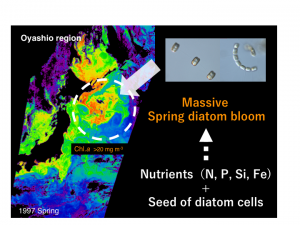Akira Kuwata
Mechanism and long-term change of spring bloom of diatoms in the Oyashio region
Research summary
Diatoms are known to thrive in turbulent and nutrient-rich waters such as coastal and upwelling waters. In the Oyashio region, western North Pacific, massive diatom blooms, such as observed in coastal regions, occur extensively in spring. These blooms could be maintaining high biological productivity in this pelagic ecosystem, where one of the world’s richest fishing ground is established.
Diatoms use silicon to form a heavy silica cell wall. Diatom cells sink rapidly with this and contribute to the “biological pump” of carbon fixed photosynthetically from the atmosphere to the deep ocean. Actually, the western North Pacific, where diatoms are blooming massively in spring, is known to be an important sink of atmospheric carbon dioxide in the global ocean.
Recently, both processes; supply of sufficient nutrients (including N, P, Si and Fe) and seeding of diatom cells which can utilize the supplied nutrients efficiently and grow actively, have been recognized to be essential for the spring blooming of diatoms in the Oyashio region. The aim of this study is to elucidate mechanism and long-term change of the spring diatom blooms in the Oyashio region by autoecological approach, focusing on seeding and growth processes.
Principal investigator:
Akira Kuwata
Tohoku National Fisheries Research Institute, FRA, Marin Ecology
Collaborator:
Hiroyuki Togashi
Tohoku National Fisheries Research Institute, FRA, Marin Ecology
Collaborator:
Kazuaki Tadokoro
Tohoku National Fisheries Research Institute, FRA, Marin Ecology
Joint cooperator:
Tsuyoshi Watanabe
Tohoku National Fisheries Research Institute, FRA, Marin Ecology






